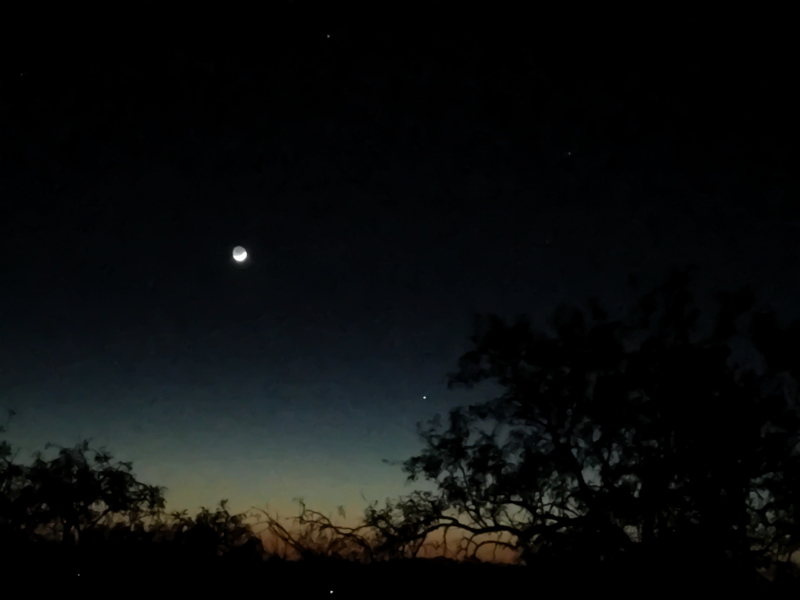Crescent Moon, Comet 41P/Tuttle-Giacobini-Kresak
Posted: 30 March 2017
Monday, 27 March 2017, was cloudy and windy. I did go to the observatory that evening as the Arizona Public Media TV crew was back to do some more video recording for their upcoming show about me. As we were finishing up the TV producer and I saw a bright fireball in the northern sky. Unfortunately, their camera was pointed in the wrong direction. That would have made a nice addition to the show!
Tuesday, 28 March, continued with clouds and wind. The clouds and wind mostly went away on Wednesday, 29 March.
|
Open: Wednesday, 29 March 2017, 1817 MST Temperature: 87°F |
Session: 1093 Conditions: Mostly clear |
Equipment Used:
12" f/8 LX600 w/StarLock
2" 24mm UWA eyepiece
2" 30mm eyepiece
2" 50mm eyepiece
2" 8-24mm zoom eyepiece
2X PowerMate
Camera:
iPhone 6s Plus
D7200 DSLR
1822 MST: LX600 ON, StarLock OFF, High Precision OFF.
1824 MST: viewed the crescent Moon through thin clouds, 102X. The thin crescent Moon was faintly visible to the naked eye 20 minutes before sunset. Viewed the Moon, 81X and 49X. 1844 MST: sunset.

This iPhone 6s Plus photo shows the thin crescent Moon at the top of the sunset sky:

Mounted the iPhone on the 12" telescope using the Levenhuk adapter for this afocal 49X image taken using the iOS app NightCap Pro (ISO 25, 1/250sec):

1900 MST: sky was clearing. Fairly good view of the crescent Moon, 49X. Switched to the Baader 8-24 zoom eyepiece. Good view of the Moon, 152X.
Took this handheld afocal 152X image with the iPhone and NightCap Pro (ISO 160, 1/90sec) showing Mare Crisium at the center:

1917 MST: began a search for Sirius B (the "Pup Star") using the zoom eyepiece without and with the Televue 2X PowerMate. No joy.
1936 MST: the Moon and the planets Mars and Mercury made a nice sight in the western sky. This is a handheld iPhone photo using the iOS Camera app (some digital zoom) showing the western sky:

Mouseover or tap on image for labels
1940 MST: slewed the 12" telescope to the star Regulus and SYNCed the AutoStar. GC Wi-Fi Adapter ON. Used the iOS app SkySafari 5 Pro on the iPhone to GOTO Comet 41P/Tuttle-Giacobini-Kresak. The comet's head and coma were nicely visible, 102X. No tail was visible.
Viewed Comet 41P using the Vortex 12x50 binoculars. The large coma was visible.
Then slewed the 12" telescope back to the star Regulus, mounted the D7200 DSLR at prime focus + focal reducer, focused using the Astrozap Bahtinov Mask, and locked the primary mirror.
2004 MST: using SkySafari Pro slewed back to Comet 41P. Wi-Fi OFF. StarLock ON. Did some framing test exposures. Then did some high ISO exposures to try to bring out the comet's coma. This is a 1 minute, ISO 12800, White Balance 3570K, StarLock autoguided exposure:

Mouseover or tap on image for label
I got lucky and also captured the Magnitude +14.52 galaxy IC836 (127 million Lightyears away) in the same image.
2025 MST: StarLock OFF. Ended imaging.
2033 MST: viewed Comet 41P again, 102X. Breezes were now coming up.
I then did some Deep Sky Object (DSO) observing, 102X, in preparation for imaging them on a future session. Viewed the galaxies NGC4038, NGC4565, NGC5529, NGC2936, NGC5395, and NGC4676. Also viewed NGC6543 (Cat's Eye Nebula, planetary nebula).
Lastly, viewed Jupiter, low in the southeastern sky, 102X. The four Galilean Moons were visible.
2105 MST: LX600 OFF.
|
Close: Wednesday, 29 March 2017, 2112 MST Temperature: 59°F |
Session Length: 2h 55m Conditions: Clear, breezy |
Comments are welcome using Email. Twitter users can use the button below to tweet this report to your followers. Thanks.
Cassiopeia Observatory Home Page
Copyright ©2017 Michael L. Weasner / mweasner@me.com
URL = http://www.weasner.com/co/Reports/2017/03/30/index.html
